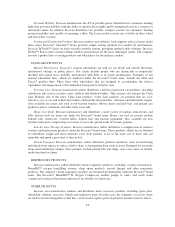Invacare 2007 Annual Report Download - page 21
Download and view the complete annual report
Please find page 21 of the 2007 Invacare annual report below. You can navigate through the pages in the report by either clicking on the pages listed below, or by using the keyword search tool below to find specific information within the annual report.receivable; difficulties in implementing a new Enterprise Resource Planning system; legal actions or regulatory
proceedings and governmental investigations; product liability claims; inadequate patents or other intellectual
property protection; incorrect assumptions concerning demographic trends that impact the market for our
products; provisions of Ohio law or in our debt agreements, our shareholder rights plan or our charter
documents that may prevent or delay a change in control; the loss of the services of our key management and
personnel; decreased availability or increased costs of raw materials which could increase our costs of
producing our products; inability to acquire strategic acquisition candidates because of limited financing
alternatives; risks inherent in managing and operating businesses in many different foreign jurisdictions;
exchange rate fluctuations, as well as the risks described from time to time in Invacare’s reports as filed with the
Securities and Exchange Commission. Except to the extent required by law, we do not undertake and specifically
decline any obligation to review or update any forward-looking statements or to publicly announce the results of
any revisions to any of such statements to reflect future events or developments or otherwise.
Item 1A. Risk Factors.
The company’s business, operations and financial condition are subject to various risks and uncertainties.
You should carefully consider the risks and uncertainties described below, together with all of the other
information in this annual report on Form 10-K and in the company’s other filings with the SEC, before making
any investment decision with respect to the company’s securities. The risks and uncertainties described below
may not be the only ones the company faces. Additional risks and uncertainties not presently known by the
company or that the company currently deems immaterial may also affect the company’s business. If any of these
known or unknown risks or uncertainties actually occur or develop, the company’s business, financial condition,
results of operations and future growth prospects could change.
Changes in government and other third-party payor reimbursement levels and practices have negatively
impacted and could continue to negatively impact the company’s revenues and profitability.
The company’s products are sold through a network of medical equipment and home health care providers,
extended care facilities, hospital and HMO-based stores, and other providers. Many of these providers (the company’s
customers) are reimbursed for the products and services provided to their customers and patients by third-party payors,
such as government programs, including Medicare and Medicaid, private insurance plans and managed care programs.
Many of these programs set maximum reimbursement levels for some of the products sold by the company in the
United States. If third-party payors deny coverage, make the reimbursement process or documentation requirements
more uncertain or further reduce their current levels of reimbursement (i.e., beyond the reductions described below), or
if the company’s costs of production increase faster than increases in reimbursement levels, the company may be
unable to sell the affected product(s) through its distribution channels on a profitable basis.
Reduced government reimbursement levels and changes in reimbursement policies have in the past added,
and could continue to add, significant pressure to the company’s revenues and profitability. Effective
November 15, 2006, the CMS reduced the maximum reimbursement amount for power wheelchairs under
Medicare by up to 28%, and implemented a series of other administrative changes that makes it more difficult for
customers to provide power wheelchairs. Additionally, the Deficit Reduction Act of 2005 includes payment cuts
for home oxygen equipment that will take effect in January 2009.
Largely as a consequence of the announced reimbursement reductions and the uncertainty created thereby,
North American net sales were lower in 2007 and 2006 as compared to 2005 and Asia/Pacific sales were also
negatively impacted as the U.S. reimbursement uncertainty in the power wheelchair market resulted in decreased
sales of microprocessor controllers by the company’s Dynamic Controls subsidiary. Sales of respiratory products
were particularly affected by the changes. Small and independent provider sales declined as these dealers slowed
their purchases of the company’s HomeFill™ oxygen system product line, in part, until they had a clearer view
of future oxygen reimbursement levels. Furthermore, a study issued by the Office of Inspector General or “OIG,”
in September 2006 suggested that $3.2 billion in savings could be achieved over five years by reducing the
reimbursed rental period from three years (the reimbursement period under current law) to 13 months.
I-16
























